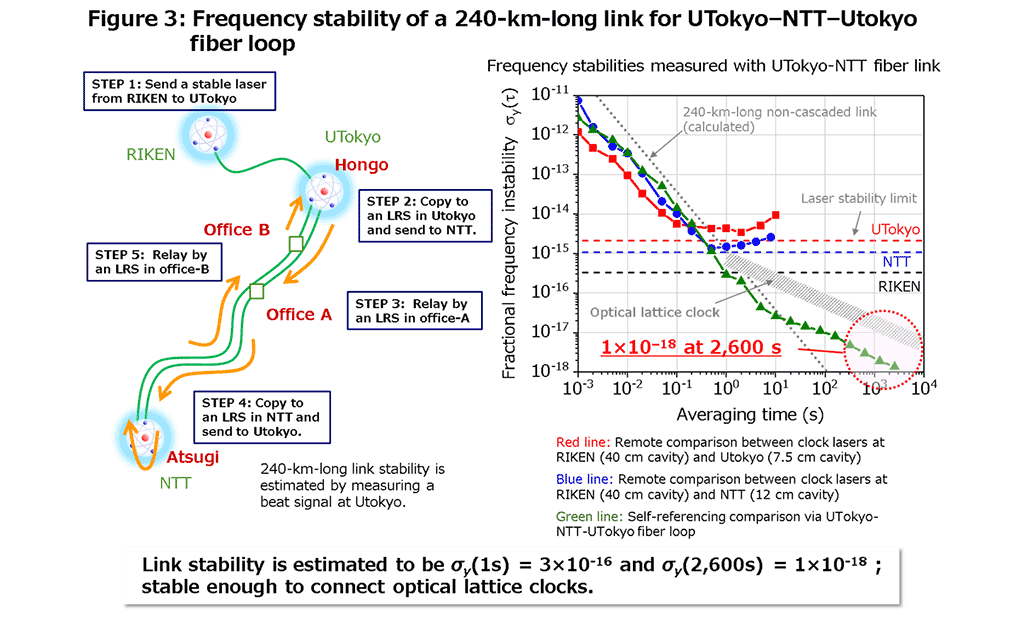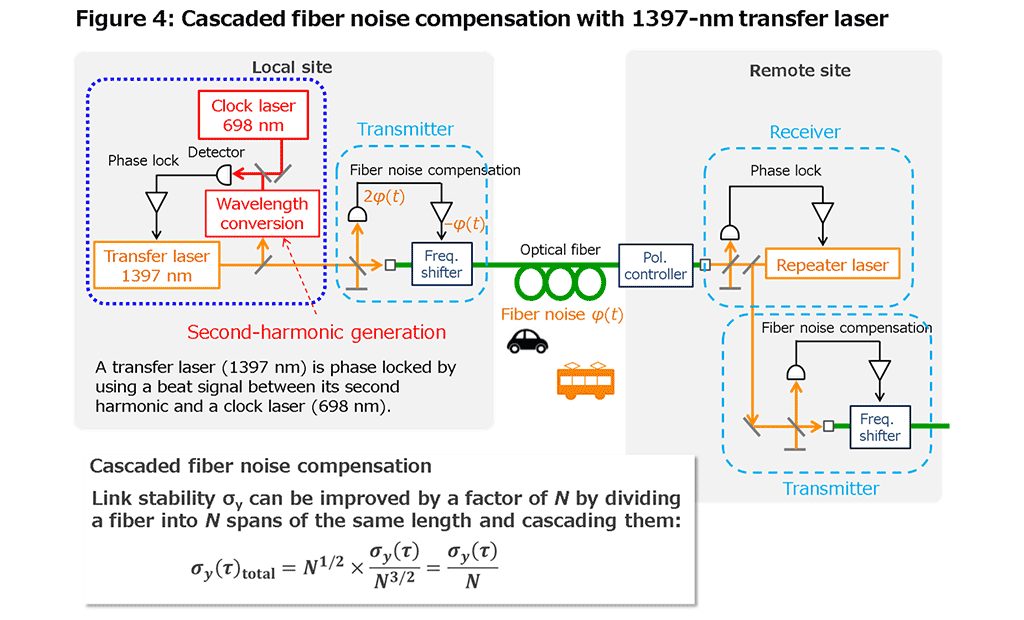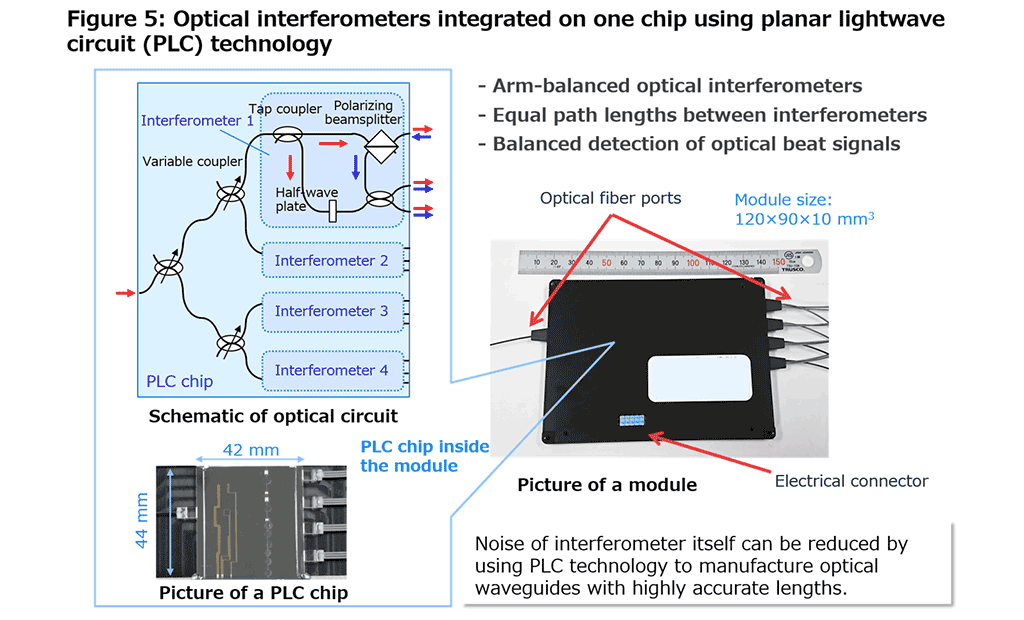Microsoft ends support for Internet Explorer on June 16, 2022.
We recommend using one of the browsers listed below.
- Microsoft Edge(Latest version)
- Mozilla Firefox(Latest version)
- Google Chrome(Latest version)
- Apple Safari(Latest version)
Please contact your browser provider for download and installation instructions.
March 18, 2020
Nippon Telegraph and Telephone Corporation
The University of Tokyo
Nippon Telegraph and Telephone East Corporation
RIKEN
Japan Science and Technology Agency (JST)
Experimental demonstration of ultra-high precision optical frequency transfer via 240-km-long telecommunications fiber
– Optical repeater cascade transfer using planar lightwave circuit (PLC) –
Nippon Telegraph and Telephone Corporation (NTT, H.Q.: Chiyoda-ku, Tokyo, President and CEO: Jun Sawada), Professor Hidetoshi Katori with the Graduate School of Engineering, The University of Tokyo (UTokyo, H.Q.: Bunkyo-ku, Tokyo, President: Makoto Gonokami) (concurrently Team Leader at the RIKEN Center for Advanced Photonics and Chief Scientist in the RIKEN Cluster for Pioneering Research), and Nippon Telegraph and Telephone East Corporation (NTT East, H.Q.: Shinjuku-ku, Tokyo, President: Fukuzo Inoue) have used commercial fiber networks and telecommunications offices to build a system to transfer optical frequencies between NTT (Atsugi R & D Center), UTokyo (Hongo), and RIKEN (Wako) and demonstrated a transfer accuracy of 1×10-18 at an averaging time of 2,600 seconds. NTT and NTT East have developed the world’s first laser repeater stations (LRSs) incorporating planar lightwave circuits (PLCs)*1 for a cascaded fiber link*2. This fiber network is stable enough to connect the world’s most precise optical lattice clocks*3 developed by UTokyo and RIKEN, which will lead to widespread applications of relativistic geodesy*4 using optical lattice clock networks.
The paper describing this work will be published in “Optics Express”, a US scientific journal of The Optical Society of America (OSA), on March 17, 2020 (US time)**.
This work was partly funded by JSPS Grant-in-Aid for Specially Promoted Research (JP16H06284) and by JST-Mirai Program (JPMJMI18A1), Japan.
Background
This work was performed as part of a project to construct a nationwide optical lattice clock network in Japan. Optical lattice clocks can achieve a frequency accuracy exceeding that cesium atomic clocks (the current time/frequency standards defining the unit of time “second”) and are thus promising candidates for the next generation of time/frequency standards. In addition, because such high-precision optical lattice clocks are sensitive to gravitational potential, using them for geodesy is attracting attention as an application that goes beyond the conventional concept of clocks (Fig. 1). According to Einstein’s theory of general relativity, a clock placed at a lower position ticks slowly due to the gravitational potential of the Earth. A clock with an accuracy of 10-18 can determine a height difference of one centimeter. Remote clocks connected through an optical fiber network are expected to provide new time-space information infrastructures, such as quantum benchmarks and quantum sensors for crustal deformation.
Realizing such clock networks requires optical fiber links that are stable enough to connect optical lattice clocks. Scalability of the fiber length is also important for a nationwide clock network. A fundamental experiment was demonstrated in 2017 [Takano et al., Nature Photonics 10, 662 (2016)], where two optical lattice clocks placed at UTokyo (Hongo) and RIKEN (Wako)were operated by a single laser shared by a 30-km-long optical fiber link.
In the present work, we demonstrated a 240-km-long optical fiber link, which corresponds to a prefecture-level network, with an accuracy of 10-18.
Research output
Three laboratories—one at NTT, one at UTokyo, and the other at Riken—located within a 100-km region were connected by optical telecommunications fibers, and shared a highly stable laser with a wavelength of 1397 nm, twice the wavelength of the lasers used for strontium optical lattice clocks. To achieve this, we developed a cascaded fiber link with ultralow-noise laser repeater stations (LRSs) incorporating planar lightwave circuits (PLCs). We demonstrated optical frequency transfer via a 240-km-long fiber with a frequency stability*5 of 3×10-16 at an averaging time of one second and 1×10-18 at 2,600 seconds. This stability is high enough to connect the world’s most precise optical lattice clocks developed by UTokyo and RIKEN, which will lead to widespread applications of relativistic geodesy using optical lattice clock networks.
Experiments
1.NTT and NTT East constructed the optical fiber network between UTokyo (Hongo) and NTT (Atsugi) using two 120-km-long fibers via three telecommunications offices. By connecting one of the fibers to a 30-km-long fiber previously constructed between RIKEN (Wako) and UTokyo, the resulting 150-km-long fiber connects the three laboratories (Fig. 2). LRSs were installed in the laboratories and telecommunications offices to implement the cascaded fiber link. All the LRSs can be remotely operated.
2.A 1397-nm transfer laser is stabilized to a 698-nm clock laser*6 at RIKEN via second-harmonic generation, and its light is sent to UTokyo via the 30-km-long fiber link. The light is copied in an LRS at UTokyo and sent to NTT via a 120-km-ling fiber link while being relayed by an LRS at office-A. From NTT, another 120-km-long fiber link with an LRS at office-B is used to send the light back to UTokyo. An optical beat signal between the two lights sent from RIKEN and NTT is detected at UTokyo. The frequency stability of the beat signal corresponds to the link stability for the 240-km-long UTokyo-NTT-UTokyo fiber loop (Fig. 3). We have estimated the link stability to be 3×10-16 at one second and 1×10-18 at 2,600 seconds (a green line in Fig. 3). This is better than stability of optical lattice clocks (a gray shaded line in Fig. 3).
Technical points
1.Cascaded optical fiber link using light at 1397 nm (UTokyo, RIKEN, and NTT)
The advantage of using a transfer laser operating at 1397 nm is that the light can be converted to the wavelength of strontium optical lattice clocks by using a simple wavelength conversion device (Fig. 4) [Akatsuka et al., Japanese Journal of Applied Physics 53, 032801 (2014)]. The transfer laser is sent through an optical fiber from a local site to a remote site while being relayed by LRSs on the way. In each LRS, the optical phase of a received light is copied to a repeater laser, which is sent to the next station with fiber noise compensation (FNC)*7 (Fig. 4). By applying the FNC for each short span, the frequency stability of the delivered light is expected to be better than that delivered by a non-cascaded link.
2.Integrated optical interferometer using silica-based optical waveguide technology (NTT)
Optical interferometers are important components in both receivers and transmitters. We applied silica-based PLC technology for the precision optical frequency transfer. Optical interferometers fabricated on a small PLC chip provide a compact, robust, and ultralow-noise optical system. In addition, arm-balanced optical interferometers on a PLC chip have shown unprecedented stability (Fig. 5).
Future work
We are planning to demonstrate an optical lattice clock network using the 200-km-level optical fiber link developed in this work. We also plan to extend this ultrahigh-precision optical-frequency transfer technology to the 1000-km level and develop an experimental environment for a nationwide optical clock network.
Glossary
- The planar lightwave circuit (PLC) is a technology for manufacturing optical waveguides with the same process used for LSIs. Silica-based PLCs were originally developed by NTT, and are now widely used in practical devices such as wavelength (de)multiplexers and optical switches in optical fiber communications systems.
- A cascaded link uses laser repeater stations to connect short-distance fiber links. This method can increase feedback bandwidth for fiber noise compensation and thus improve overall transfer stability.
- An optical lattice clock is a type of atomic clock proposed in 2001 by then Associate Professor Hidetoshi Katori of the University of Tokyo. Atoms are confined in small spaces measuring tens of nanometers (a nanometer is one billionth of a meter) created by an interference fringe of laser light (called an “optical lattice”) tuned to a special wavelength called the “magic wavelength.” An optical lattice clock employing thousands of atoms can realize high-precision frequency measurements with short averaging times.
- Relativistic geodesy is an application of atomic clocks to geodesy. According to Einstein’s theory of general relativity, “time goes slow around heavy objects.“ A high-precision atomic clock can observe this effect and determine the height of the clock with an accuracy of one centimeter.
- Frequency stability refers to how much the frequency of an oscillator fluctuates during a certain averaging time. This is expressed as the ratio of frequency variation, measured at a gate time, with respect to the center frequency.
- A clock laser is used to interrogate the resonance frequency of atoms. The measured resonance frequency is copied to the laser frequency, which corresponds to reading the time reference of the optical lattice clock.
- Fiber noise compensation is a method for suppressing frequency noise induced on a light delivered by an optical fiber. Fiber noise is detected by measuring a beat signal between a light at the transmission source and a light sent back from a remote site. By applying the detected fiber noise on the transmission light with the opposite phase, the delivered light becomes accurate and stable (Fig. 4).
** Paper:omoya Akatsuka,* Takashi Goh, Hiromitsu Imai, Katsuya Oguri, Atsushi Ishizawa, Ichiro Ushijima, Noriaki Ohame, Masao Takamoto, Hidetoshi Katori, Toshikazu Hashimoto, Hideki Gotoh, and Tetsuomi Sogawa, “Optical frequency distribution using laser repeater stations with planar lightwave circuits,” Optics Express, Volume 28, Issue 7, pp. 9186-9197 (2020).
OSA news release: https://www.osa.org/en-us/about_osa/newsroom/news_releases/
Attachments





Inquiries regarding this matter
Nippon Telegraph and Telephone Corporation
NTT Science and Core Technology Laboratory Group, Public Relations
E-mail:science_core-pr-ml@hco.ntt.co.jp
Tel: 046-240-5157
The University of Tokyo
Graduate School of Engineering, Public Relations
E-mail:kouhou@pr.t.u-tokyo.ac.jp
Tel: 03-5841-6295
Nippon Telegraph and Telephone East Corporation
Public Relations
E-mail:houdou-gm@east.ntt.co.jp
Tel: 03-5359-3711
RIKEN
Public Relations
E-mail:ex-press@riken.jp
Tel: 048-467-9272
Fax: 048-462-4715
Japan Science and Technology Agency (JST)
Public Relations Division
E-mail:jstkoho@jst.go.jp
Tel: 03-5214-8404
Fax: 03-5214-8432
Information is current as of the date of issue of the individual press release.
Please be advised that information may be outdated after that point.
NTT STORY
WEB media that thinks about the future with NTT










